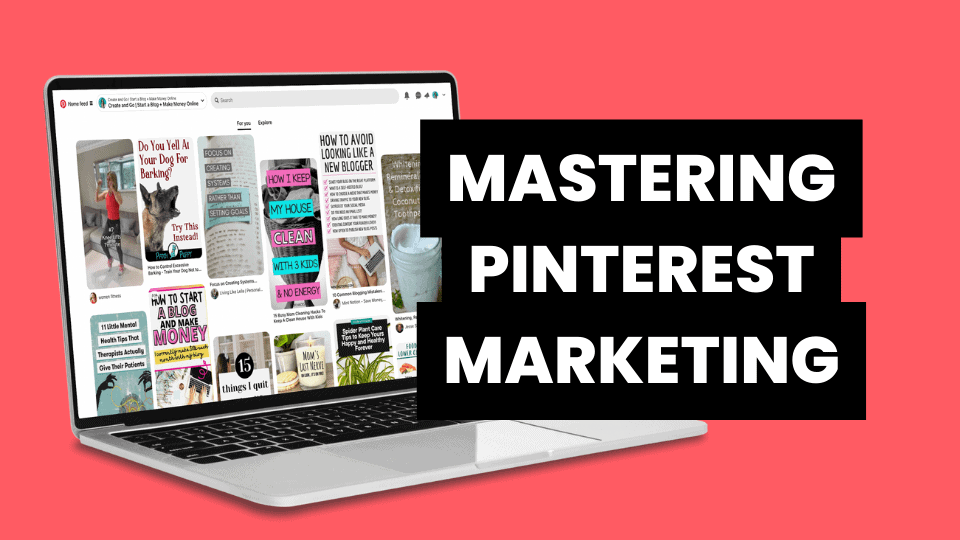Pinterest offers more than just a platform to discover recipes, DIY ideas, and fashion inspiration; it’s also a powerful tool for generating income.
With its visually-driven interface, Pinterest attracts millions of users looking to shop, plan, and explore, providing an ample audience for creators and businesses alike.
Utilizing a variety of strategies such as affiliate marketing, promoted pins, and selling products or services, individuals can turn their Pinterest activity into a profitable endeavor.

Being successful on Pinterest involves understanding the platform’s unique ecosystem, creating engaging content tailored to your target audience, and effectively marketing your pins.
Establishing a comprehensive Pinterest presence includes setting up a business account, developing a content strategy that showcases your brand, and optimizing your pins for discoverability.
Through consistent engagement and strategic promotion, users can expand their reach and connect with potential customers on Pinterest.
Key Takeaways
- Pinterest serves as a dynamic market for monetization through affiliate marketing, product sales, and promoted content.
- Effective Pinterest use requires a robust understanding of the platform, content creation, and curation tailored to a target demographic.
- Growth on Pinterest is achieved through strategic account management and consistent audience engagement.
Jump ahead:
Understanding Pinterest
Before diving into the strategies for monetization, one must grasp the platform’s essentials and recognize its potential for generating revenue.
The Basics of Pinterest
Pinterest operates as a visual search engine where users find inspiration, ideas, and products.
It’s organized around “Pins,” which are images that users can save to their thematic “Boards.” They can follow other users or boards that match their interests.
A user needs to understand how to effectively create Pins and organize them in a manner that resonates with their target audience.
Pinterest’s Potential for Monetization
Pinterest provides a unique opportunity for monetization due to its user base that actively seeks ideas and products. With features like “Rich Pins” which offer more detail than a standard pin, including price and availability, businesses can drive traffic directly to their e-commerce sites.
A Pinterest business account unlocks analytics and advertising options, aiding in the development of a strategic approach tailored for business growth.
Users can also engage in affiliate marketing or utilize Pinterest to amplify their brand and drive sales.
Setting Up Your Pinterest Account

A well-established Pinterest account is fundamental for anyone looking to monetize their presence on the platform.
The setup process involves creating a business account and optimizing your profile for maximum visibility and engagement.
Creating a Business Account
To begin monetizing on Pinterest, one must first create a business account, which offers advanced features such as analytics and ads.
Users can either convert their existing account or sign up for a new business account on the Pinterest for Business page.
It’s essential to fill in all the details accurately, including contact information and the website associated with the business.
Optimizing Your Profile
Once your business account is active, optimizing your profile is key.
This includes:
- Profile Picture: Selecting a high-quality, recognizable image that represents the brand. It could be a logo or a professional headshot.
- Username and Name: Choosing a username that aligns with the brand name, ensuring it is consistent across all social platforms. Your public name should be clear and identifiable.
- Profiles should feature a:
- Bio: Composing a concise, keyword-rich description that clearly states what the brand offers and includes a call-to-action.
- Location: Adding a location if applicable, to attract local traffic.
- Contact Details: Ensuring contact information is up to date for business inquiries.
The profile should be viewed as a storefront, inviting and informing visitors while encouraging them to explore your pins and boards.
Content Creation and Curation
Effective content creation and curation on Pinterest are crucial for attracting and retaining an audience, and ultimately enabling monetization opportunities.
Developing a Content Strategy
A well-defined content strategy sets the foundation for success on Pinterest.
Creators must identify their niche and set clear objectives, such as driving traffic to their website or building brand awareness.
They should conduct research to understand their target audience and determine the types of content that resonate.
A content calendar can help maintain a consistent posting schedule.
Designing Engaging Pins
Engaging pins are the currency of Pinterest. High-quality images or graphics with a vertical aspect ratio (2:3) are recommended.
Using tools like Adobe Spark or Canva, creators should incorporate bold text overlays and consistent branding elements.
It’s important to create clear, compelling images that encourage users to click through.
Curating Boards with a Focus
Curating boards involves more than just pinning randomly; it requires a focused approach.
Each board should revolve around a specific topic, making it easy for users to follow and find relevant content.
It’s beneficial to mix a creator’s own pins with related content from others to provide value, but you can also stick to only sharing your own pins if you have enough content to share.
Regularly updating boards with fresh content is key, as is ensuring that the board descriptions use relevant keywords to improve discoverability.
Growing Your Pinterest Presence
To effectively monetize a Pinterest account, one needs to grow their presence on the platform.
This involves optimizing content for search, engaging actively with the Pinterest community, and leveraging analytics to inform strategy.
Implementing SEO Best Practices
A crucial component for growth is to use SEO best practices.
Creators should focus on incorporating relevant keywords in their pin titles, descriptions, and image alt-text to increase visibility.
For instance, adding trending keywords to your content can enhance discoverability.
Engaging with the Community
Community engagement is also key.
They should respond to comments on their pins, repin others’ content that aligns with their brand, and participate in group boards.
Consistent interaction can help in building relationships with followers and broadening reach.
Utilizing Analytics for Growth
Using analytics tools efficiently can provide insights for growth. Pinterest creators should regularly review their analytics to understand their audience better and tailor their content strategy accordingly.
Learning which content drives the most engagement can guide them to make informed decisions about what to create next. A strategic approach includes reviewing traffic sources as advised by Buffer.
If you’re serious about growing your Pinterest account, I recommend the Mastering Pinterest Marketing course by Create and Go.

Monetization Strategies
Pinterest offers several avenues for monetization, each with its own set of tactics and income potential.
Content creators and businesses can leverage Pinterest’s unique visual platform and engaged user base to turn their creative efforts into revenue.

Affiliate Marketing on Pinterest
Affiliate marketing on Pinterest involves promoting products by sharing affiliate pins. Once users create an account optimized for business, they can share pins with affiliate links.
Every time a user clicks on these links and makes a purchase, the pin’s creator earns a commission.
Learning how to strategically place affiliate pins can increase the potential for earnings considerably.
Sponsored Content and Partnerships
Content creators on Pinterest can form partnerships with brands to create sponsored content.
They can leverage their engaged audience to promote a brand’s products or services.
The key to success in sponsored partnerships is to maintain authenticity and align the content with the interests of the audience on Pinterest.
Selling Products or Services
Pinterest can act as a powerful channel for selling products or services directly to consumers.
By creating appealing product pins and curating them into themed boards, sellers can visually showcase their offerings to potential buyers who are ready to make a purchase.
Driving Website Traffic
Pinterest can be instrumental in driving traffic to a website or blog.
By creating high-quality pins that link back to their website content, creators can increase their site’s visibility and attract more visitors.
This, in turn, can lead to increased ad revenue, more leads for service-based businesses, and higher sales for online stores.
Getting Views On Your YouTube Videos
Creators can use Pinterest to drive views to their YouTube content by creating pins that link directly to their videos.
By optimizing the pin description with keywords and ensuring that the thumbnail is visually engaging, creators can attract Pinterest users who are interested in their video content and encourage them to watch and subscribe on YouTube.
Leveraging Pinterest Ads
Pinterest Ads offer a visual and engaging way to reach potential customers.
They can drive significant traffic to one’s website, ultimately increasing revenue.
Creating Effective Ads
To create effective Pinterest ads, one must focus on high-quality and visually appealing images that reflect the brand’s aesthetic.
The ad’s text overlay should be kept to a minimum and include a clear call-to-action (CTA). Using high-resolution images and ensuring that the ad format aligns with Pinterest’s best practices is crucial for success.
Targeting the Right Audience
Targeting the right audience is essential for the effectiveness of Pinterest Ads. Advertisers should utilize Pinterest’s robust targeting options, which include interests, demographics, and keywords.
Additionally, retargeting tools allow advertisers to reach users who have previously engaged with their content or website, increasing the likelihood of conversion.
Analyzing and Adapting
In the landscape of Pinterest monetization, continuous analysis and adaptation are pivotal.
Creators and marketers need to track performance meticulously and refine strategies to stay ahead.
Performance Tracking
A creator must establish robust performance tracking measures to understand the impact of their Pinterest content.
Tools like Pinterest Analytics provide valuable insights into key metrics such as pin impressions, click-through rates, and audience demographics.
Analyzing engagement patterns on individual pins can illuminate what content resonates most with the audience. For instance, a high number of repins might indicate a piece of content’s viral potential.
- Engagement Metrics: Track likes, comments, and repins to gauge content popularity.
- Traffic Data: Monitor the number of visitors driven to your website from Pinterest pins.
Strategy Refinement
Based on the collected data, strategy refinement should be promptly undertaken.
If certain pins perform exceptionally well, a marketer might consider creating similar content or even repurposing high-performing pins into new formats.
On the other hand, underperforming pins might highlight the need for a different approach, such as altering the visual components or the accompanying text.
- Content Analysis: Assess which content types yield the best engagement and conversion rates.
- A/B Testing: Employ A/B testing to compare different versions of pins and establish the most effective elements.
By engaging in performance tracking and strategy refinement, one ensures a flexible and data-driven approach to Pinterest’s success, capitalizing on what works and swiftly moving away from what doesn’t.
Frequently Asked Questions
This subsection provides clear, concise answers to common questions about monetizing Pinterest, detailing strategies for newcomers, affiliate marketing practices, the Pinterest Creator Fund, and various pathways to profitability on the platform.
Newcomers can monetize Pinterest by converting their account to a business profile, creating high-quality, engaging content targeted to their niche audience, and utilizing Pinterest’s built-in analytics to refine their strategy. They may also consider exploring brand partnerships to expand their earning potential.
Individuals earn money on Pinterest through affiliate marketing by promoting products using affiliate links in their pins. By creating attractive pin images that lead to merchants’ products, pinners can receive commissions for sales made through their unique links. It’s essential to disclose the use of affiliate links to maintain transparency with followers.
The Pinterest Creator Fund is a program designed to support creators financially and through educational content to help them grow on the platform. Creators can benefit from the fund by receiving financial compensation for creating original, engaging content, as well as opportunities for growth and partnerships.
To make a profit on Pinterest through followers, creators must build an engaged audience by consistently posting relevant, high-quality content. The number of followers can enhance a creator’s credibility and appeal to brands for sponsorships, but engagement rates often play a more critical role in profitability.
While sharing images is a fundamental aspect of Pinterest, generating income typically requires more strategic action. Creators should aim to share images that drive traffic to monetized websites, promote products or services, or are part of paid partnerships to turn visual content into a source of income.
Creators can make money in collaboration with Amazon by signing up for the Amazon Associates program and sharing pins with embedded affiliate links to Amazon products. After the approval, one can start creating and sharing pins that attract Pinterest users to Amazon, where any purchases made will provide the creator with a commission.